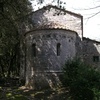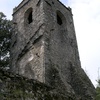Castle of Cune
The settlement of Cune is located on a high plateau not far from the peak of Mount Bargiglio, but connected by a mountain trail that unites the Serchio valley with the Pedogna stream.
Today there are visible traces of the ancient walls surrounding the village and their appearance can also be reconstructed from a vignette by Giovanni Sercambi.
The most important place of worship is the Church of Saint Mary, which houses important paintings by Marracci (17th century) and a wooden polychrome statue depicting St. Bartholomew from the 14th century.
With a short walk of about 40 minutes, you can reach the hermitage of St. Bartholomew and the summit of Mount Bargiglio and the ruins of a watchtower.
In recent years, Mount Agliale, near Cune, has become home to an important astronomical observatory.
Historical notes
The first mention of the castle of Cune dates from 1027, but there is no further mention until 1185, when Frederick I decreed that the City of Lucca reconstruct it, after damage had been sustained with the intention of striking at the Suffredinghi family. Finally, the settlement was stripped of its defences (walls and towers) in 1373, when soldiers from Lucca came to Mount Bargiglio to quell the rebellion of the descendants of Francesco Antelminelli, who continued to use the castle on the hill as a base for carrying out raids in surrounding areas. Cune, which was located a short distance from the rebel stronghold, blocked the access road and for this reason it was hit.











